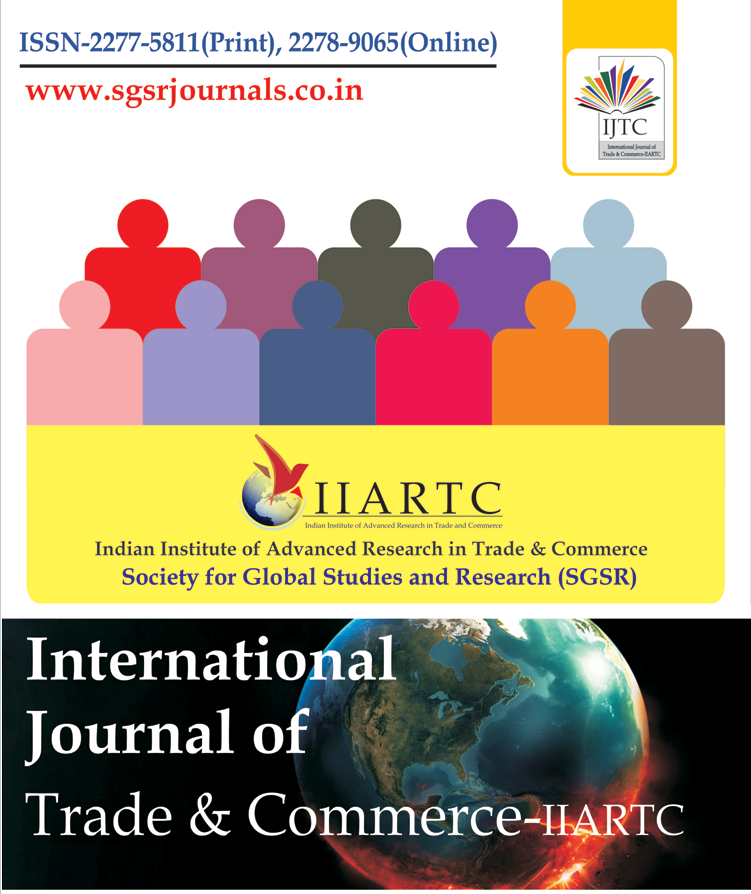Home ⇨ International Journal of Trade & Commerce-IIARTC

International Journal of Trade & Commerce-IIARTC
Impact Factor (IF):5.135 (COSMOS), IF:7.249 (ISRA), IF:3.721 (ISI)
ISSN:2277-5811 (P), ISSN:2278-9065 (O)
Frequency: Half Yearly
Study of Differences in Purchase Behaviour for High Involvement Consumer Durable Goods in Districts of Rajasthan
In a globalised economy, markets are characterized by competition. The fast innovations of technologies are intensifying the intensity of competition and are becoming challenge for every business. In the past few years, due to competition, continuously company margins are considerably declining. According to Philip Kotler (2003), in hyper competition, power is clearly shifting to consumers who are increasingly telling what product features they want, what communication they will tolerate, what incentives they expect and what price they will pay. It is high time for marketers to study, understand and predict consumer behaviour in order to survive, sustain and grow in this highly competitive and volatile market. In fact, consumer behaviour is the process whereby individuals decide whether, what, when, where, how and from whom to purchase goods and services (Walter and Paul, 1970). As a field of study, consumer behaviour focuses upon consumer activities (Blackwell, Miniard, Engel, 2001). Moreover, the scholars of human behaviour are highly concerned to study the consumer behaviour in order to gain deeper insights into why individuals are involved in certain consumption related behaviour and interested to know what internal and external factors influences them in their consumption related decisions. Zikmund (2001) is of opinion that human behavior of any kind (B) is a function (f) of the interaction between the person (P) and the environment (E)–that is B= f (P,E). According to Zikmund, consumer behaviour is the function of personal factors (age and stages of life cycle, occupation, economic situation, life style, personality, psychology etc.) and environmental factors (culture, sub-culture, social class, reference groups, family, role and status).
Author:U.C. Sharmaa, Mayank Sharmab*
Abstract:In a globalised economy, markets are characterized by competition. The fast innovations of technologies are intensifying the intensity of competition and are becoming challenge for every business. In the past few years, due to competition, continuously company margins are considerably declining. According to Philip Kotler (2003), in hyper competition, power is clearly shifting to consumers who are increasingly telling what product features they want, what communication they will tolerate, what incentives they expect and what price they will pay. It is high time for marketers to study, understand and predict consumer behaviour in order to survive, sustain and grow in this highly competitive and volatile market. In fact, consumer behaviour is the process whereby individuals decide whether, what, when, where, how and from whom to purchase goods and services (Walter and Paul, 1970). As a field of study, consumer behaviour focuses upon consumer activities (Blackwell, Miniard, Engel, 2001). Moreover, the scholars of human behaviour are highly concerned to study the consumer behaviour in order to gain deeper insights into why individuals are involved in certain consumption related behaviour and interested to know what internal and external factors influences them in their consumption related decisions. Zikmund (2001) is of opinion that human behavior of any kind (B) is a function (f) of the interaction between the person (P) and the environment (E)–that is B= f (P,E). According to Zikmund, consumer behaviour is the function of personal factors (age and stages of life cycle, occupation, economic situation, life style, personality, psychology etc.) and environmental factors (culture, sub-culture, social class, reference groups, family, role and status).




